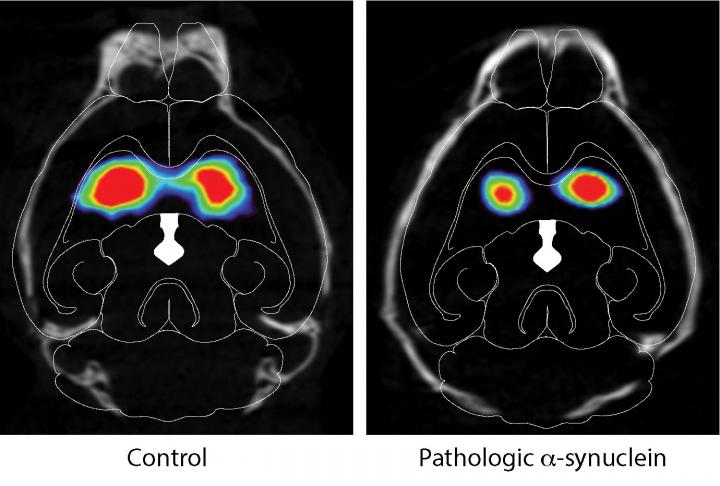
Credit: Ted Dawson et al. / Neuron, 2019
Parkinson’s disease can begin in the gut and spread to the brain via the vagus nerve, researchers report June 26th in the journal Neuron. This pathway was observed in a new mouse model, which recapitulates both motor and non-motor deficits as well as early-stage and late-stage features associated with Parkinson’s disease.
“Since this model starts in the gut, one can use it [to] study the full spectrum and time course of the pathogenesis of Parkinson’s disease,” says co-senior study author Ted Dawson, professor of neurology at the Johns Hopkins University School of Medicine. “For instance, one could test preventive therapies at early pre-symptomatic stages of Parkinson’s disease all the way to full-blown Parkinson’s disease in one animal model.”
Hallmarks of Parkinson’s disease include the aggregation of misfolded forms of a neuronal protein called α-synuclein and the selective death of neurons that produce dopamine in a brain region called the substantia nigra pars compacta (SNc). The disorder causes motor symptoms such as tremors, rigidity, slowness of movement, and difficulties with balance, speech, and coordination. There is no cure, and currently available treatments do not slow or stop disease progression or adequately relieve the wide range of symptoms at more advanced stages.
Based on evidence in the post-mortem human brain, German neuroanatomist Heiko Braak and colleagues proposed in 2003 that α-synuclein pathology can spread from the gastrointestinal tract via the vagus nerve to the SNc, where it selectively kills dopamine-producing neurons. Accumulating evidence supports this gut-brain connection, but until now, animal models have not demonstrated the spread of pathologic α-synuclein from the gut via the vagus nerve to the SNc, as proposed by Braak.
In the new study, Dawson and co-senior study author Han Seok Ko of the Johns Hopkins University School of Medicine developed a mouse model that supports Braak’s hypothesis. The authors injected mouse α-synuclein preformed fibrils into gastrointestinal muscles densely innervated by the vagus nerve. The key to success was optimizing the injection site as well as the amount and size of α-synuclein preformed fibrils injected. “When the initial experiments started to work, we were utterly amazed,” Dawson says. “Now it is fairly routine for our research team.”
One month after injection, the researchers observed that pathologic α-synuclein had spread to the dorsal motor nucleus of the vagus, located in the lowest part of the brainstem; this corresponds to Braak’s stage 1. Within three months, pathologic α-synuclein had spread up the brainstem to the locus coeruleus and higher to the SNc, and even reached beyond the brainstem to the amygdala, hypothalamus, and prefrontal cortex, corresponding to later Braak stages. By seven months, pathologic α-synuclein had spread to additional brain regions, including the hippocampus, striatum, and olfactory bulb.
By this time, there was also significant loss of dopamine-producing neurons in the SNc and striatum. In addition to motor deficits, mice that received gastrointestinal injections of α-synuclein preformed fibrils developed signs of depression and anxiety, olfactory dysfunction, and cognitive deficits affecting spatial learning and memory, novel object recognition, fear memory, and working memory. The transmission of pathologic α-synuclein from the gut to the brain and the resulting neuronal death and symptoms did not occur in mice whose vagal nerve fibers were cut.
“There are at least three major implications of the study,” Dawson explains. “One: it is likely to galvanize future studies exploring the gut-brain connection. Two: it will spur investigations focused on the factors, molecules, or infections that might start the misfolding and propagation of α-synuclein. And three: it suggests that treatments could be aimed at preventing the spread of pathologic α-synuclein from the gut to brain.”
According to Dawson and Ko, the findings strongly support Braak’s hypothesis, but it may be difficult to provide the same kind of evidence for the gut-brain connection in humans. However, studies in humans have shown that truncal vagotomy–a specific surgical procedure on the vagus nerve, typically used to treat ulcers–may reduce the risk of Parkinson’s disease.
“Patients should not pursue vagotomies as a preventive therapy for Parkinson’s disease,” Dawson cautions. “But if one could find the major initiating factor in the gut, then one could target this in a future study and show that it prevents Parkinson’s disease. Patients with pathologic α-synuclein in the gastrointestinal tract would be ideal candidates for future neuroprotective studies.”
Moving forward, the researchers plan to assess whether the findings extend to non-human primates and to further investigate the mechanisms underlying the spread of pathologic α-synuclein from the gut to the brain and the resulting motor and non-motor symptoms. They will also look for potential gastrointestinal biomarkers associated with early pre-symptomatic stages of the disease and test potential therapeutic interventions that interfere with the spread of pathologic α-synuclein and mitigate the risk of developing Parkinson’s disease.
###
This work was supported by grants from the JPB Foundation, the NIH/NINDS Morris K. Udall Parkinson’s Disease Research Center, and NIH/NINDS. The authors declare no competing interests.
Neuron, Kim and Kwon et al.: “Transneuronal Propagation of Pathologic a-Synuclein from the Gut to the Brain Models Parkinson’s Disease” https://www.cell.com/neuron/fulltext/S0896-6273(19)30488-X
Neuron (@NeuroCellPress), published by Cell Press, is a bimonthly journal that has established itself as one of the most influential and relied upon journals in the field of neuroscience and one of the premier intellectual forums of the neuroscience community. It publishes interdisciplinary articles that integrate biophysical, cellular, developmental, and molecular approaches with a systems approach to sensory, motor, and higher-order cognitive functions. Visit: http://www.
Media Contact
Carly Britton
[email protected]
Related Journal Article
http://dx.




